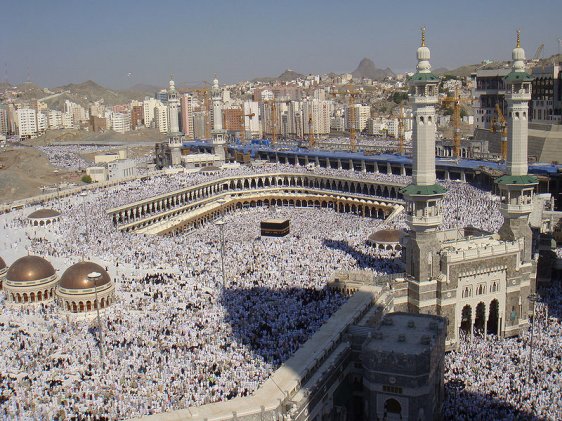And when We assigned to Ibrahim the place of the House (Kaaba), saying: Do not associate with Me aught, and purify My House for those who make the circuit and stand to pray and bow and prostrate themselves.
—Qur'an, [Quran 22:26]
And when We made the House a resort for men and a place of security. And: Take ye the place of Abraham for a place of prayer. And We enjoined Ibrahim and Ismael, saying: Purify my House for those who visit it and those who abide in it for devotion and those who bow down and those who prostrate themselves.
—Qur'an, [Quran 2:125]
And when Ibrahim and Ismael raised the foundations of the House (Kaaba): Our Lord! accept from us; surely Thou art the Hearing, the Knowing.
—Qur'an, [Quran 2:127]
Muslim belief places the story of Ismael and his mother's search for water in the general vicinity of the mosque. In the story, Hagar runs between the hills of Safa and Marwah looking for water for her infant son, until God eventually reveals to her the Zamzam Well, from where water continues to flow to this day.
After the Hijra, upon Muhammed's victorious return to Mecca, Muhammad and his son-in-law, Ali ibn Abi Talib, removed all the idols in and around the Kaaba and cleansed it. This began the Islamic rule over the Kaaba, and the building of a mosque around it.
The first major renovation to the Mosque took place in 692. Before this renovation, which included the mosque's outer walls being raised and decoration added to the ceiling, the Mosque was a small open area with the Kaaba at the centre. By the end of the 700s, the Mosque's old wooden columns had been replaced with marble columns and the wings of the prayer hall had been extended on both sides along with the addition of a minaret. The spread of Islam in the Middle East and the influx of pilgrims required an almost complete rebuilding of the site which included adding more marble and three more minarets.
The mosque was renovated in 1570 by Sultan Selim II's private architect and it resulted in the replacement of the flat roof with domes decorated with calligraphy internally and the placement of new support columns. These features (still present at the Mosque) are the oldest surviving parts of the building and are in fact older than the Kaaba itself (discounting the black stone) which is currently in its fourth incarnation made in 1629. The Saudi government acknowledges 1570 as the earliest date for architectural features of the present Mosque.
Following further damaging rain in the 1620s, the Mosque was renovated yet again: a new stone arcade was added, three more minarets were built and the marble flooring was retiled. This was the unaltered state of the Mosque for nearly three centuries.
 Masjid Al Haram
Masjid Al Haram Masjid Al Haram
Masjid Al Haram Masjid Al Haram
Masjid Al Haram Masjid Al Haram
Masjid Al Haram Masjid Al Haram
Masjid Al Haram
No comments:
Post a Comment